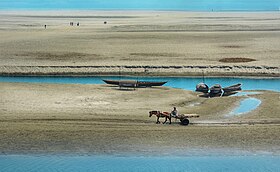Our website is made possible by displaying online advertisements to our visitors.
Please consider supporting us by disabling your ad blocker.
Gaibandha District
Gaibandha District
গাইবান্ধা জেলা | |
|---|---|
Clockwise from top-left: Jamuna river, Jamalpur Shahi Mosque, Fulchari Ghat, Friendship Centre | |
 Location of Gaibandha in Bangladesh | |
 Expandable map of Gaibandha | |
| Coordinates: 25°15′N 89°30′E / 25.25°N 89.50°E | |
| Country | Bangladesh |
| Division | Rangpur Division |
| Government | |
| • Deputy Commissioner | Md. Abdul Matin |
| Area | |
• Total | 2,114.77 km2 (816.52 sq mi) |
| Elevation | 27 m (89 ft) |
| Population | |
• Total | 2,562,233 |
| • Density | 1,175.73/km2 (3,045.1/sq mi) |
| Time zone | UTC+06:00 (BST) |
| Postal code | 5700 |
| Area code | 0541 |
| ISO 3166 code | BD-19 |
| Website | www |
Gaibandha District (Bengali: গাইবান্ধা জেলা) is a district in northern Bangladesh, located within the Rangpur Division. Covering an area of 2,179.27 square kilometers (841.42 sq mi), it had a population of 2,562,232 as of the 2022 census. The district's administrative headquarters and largest urban center is Gaibandha town. Originally established as a subdivision in 1875 under the name Bhabaniganj, it was renamed Gaibandha in the same year. On February 15, 1984, Gaibandha was officially upgraded to district status. The district is known for its agricultural production, particularly rice, jute, and vegetables, and is situated at the confluence of several major rivers, including the Jamuna, Teesta, and Brahmaputra.
- ^ "Elevation of Gaibandha District, Bangladesh". Retrieved 25 October 2024.
- ^ Cite error: The named reference
2022census-prelimwas invoked but never defined (see the help page).
Previous Page Next Page






